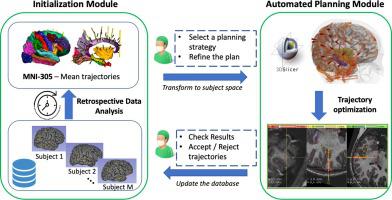Journal of Biomedical informatics ( IF 4.5 ) Pub Date : 2020-06-05 , DOI: 10.1016/j.jbi.2020.103460 Davide Scorza 1 , Michele Rizzi 2 , Elena De Momi 3 , Camilo Cortés 4 , Álvaro Bertelsen 4 , Francesco Cardinale 2

|
Surgical planning for StereoElectroEncephaloGraphy (SEEG) is a complex and patient specific task, where the experience and medical workflow of each institution may influence the final planning choices. To account for this variability, we developed a data-based Computer Assisted Planning (CAP) solution able to exploit the knowledge extracted by past cases. By the analysis of retrospective patients’ data sets, our system proposes a pool of trajectories commonly used by the institution, which can be selected to initialize a new patient plan. An optimization framework adapts those to the patient’s anatomy by optimizing clinical requirements (e.g. distance from vessel, gray matter recording and insertion angle), and adapting its strategy based on the trajectory type selected.The system has been customized based on the data of a single institution. Two neurosurgeons, working in a high-volume hospital, have validated it by using 15 retrospective patient data sets, with more than 200 trajectories reviewed. Both surgeons considered of the optimized trajectories as clinically feasible ( inter-rater reliability). Quantitative comparison of distance from vessels, insertion angle and gray matter recording index showed that the optimized trajectories reached superior or comparable values with respect to the original manual plans. The results suggest that a tailored center-based solution could increase the acceptance rate of the automated trajectories proposed.
中文翻译:

基于知识的立体脑电图自动计划系统:基于中心的方案。
立体脑电图(SEEG)的外科手术计划是一项复杂且针对患者的任务,每个机构的经验和医疗工作流程可能会影响最终的计划选择。为了解决这种可变性,我们开发了基于数据的计算机辅助计划(CAP)解决方案,该解决方案能够利用过去案例中提取的知识。通过对回顾性患者数据集的分析,我们的系统提出了该机构常用的轨迹池,可以选择这些轨迹来初始化新的患者计划。优化框架通过优化临床要求(例如距血管的距离,灰质记录和插入角度),并根据所选的轨迹类型来调整其策略,从而使这些适应于患者的解剖结构。该系统已基于单个数据进行了定制机构。两家在大型医院工作的神经外科医师通过使用15种回顾性患者数据集,对200多个轨迹进行了审查,对其进行了验证。两位外科医生都考虑过 在临床上可行的优化轨迹评价者间的可靠性)。到容器的距离,插入角度和灰质记录指数的定量比较表明,相对于原始的手动计划,优化的轨迹达到了优越或可比的值。结果表明,量身定制的基于中心的解决方案可以提高建议的自动轨迹的接受率。


























 京公网安备 11010802027423号
京公网安备 11010802027423号